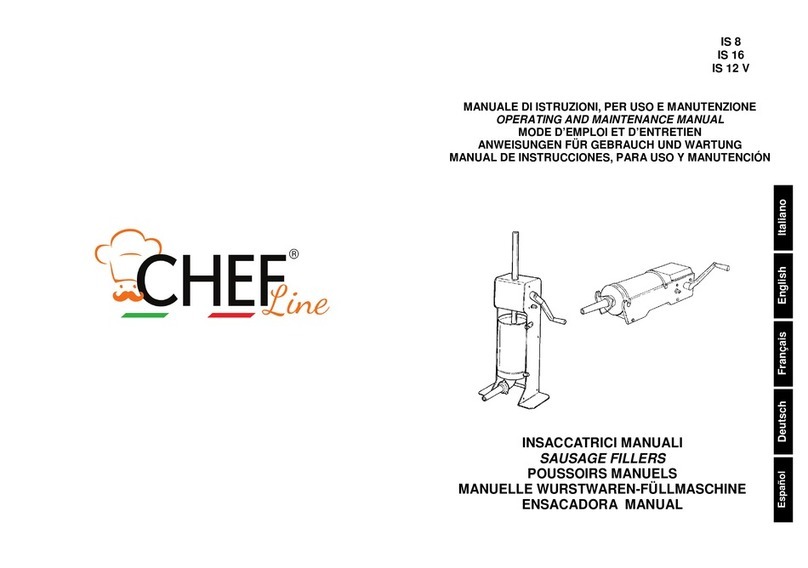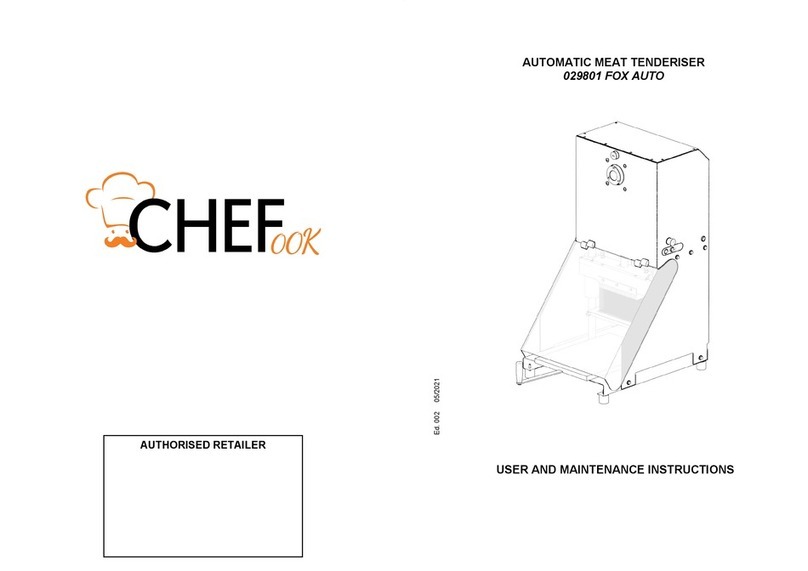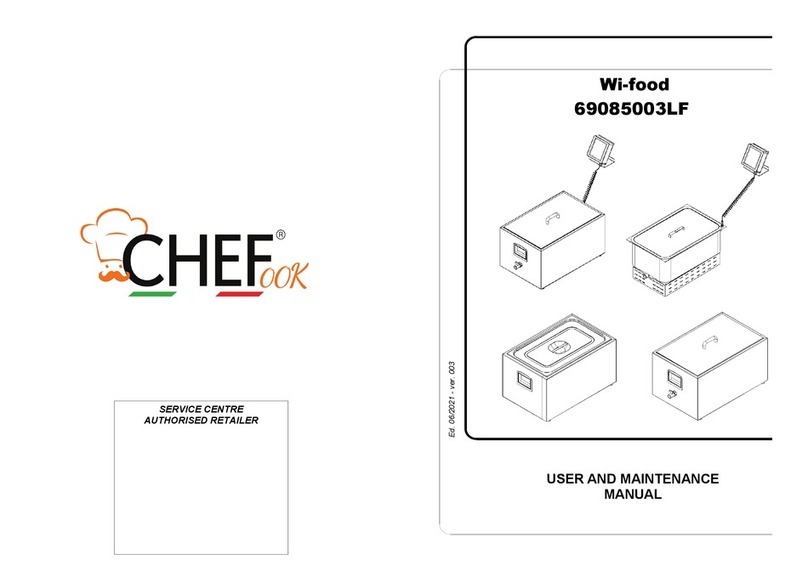CHEFOOK 69200002LF Operating instructions

16
SERVICE CENTRE
AUTHORISED DEALER
User and maintenance manual
Softcooker Wi-food _003 Ed. 03/2020
Softcooker Wi-Food
69200002LF

2
PREFACE
- This manual provides the client with information about the machine and applicable
regulations, as well as the user and maintenance instructions required to use the
machine properly and keep it in good working order.
- The manual must be made available to all users and maintenance
technicians.
CONTENTS
PART 1 - INFORMATION ABOUT THE MACHINE 4
1.1 - General precautions
1.2 - Safety equipment
1.3 - Description of the machine
1.3.1 - general description
1.3.2 - construction
1.4 - Intended use
1.5 - Improper use
1.6 - Technical data
1.7 - Protective and safety equipment
1.8 - Structure of the machine
PART 2 - TECHNICAL DATA 8
2.1 - Overall dimensions, weight, specifications ...
PART 3 - DELIVERY 9
3.1 - Shipping
3.2 - Checks on delivery
3.3 - Disposing of packaging
PART 4 - INSTALLATION 10
4.1 - Positioning
4.2 - Electrical hookup
4.3 -Wiring diagram
PART 5 - USE 11
5.1 - Using the machine
5.2 - Controls
5.3 - Program types
5.3.1 - manual cooking
5.3.2 - programmed cooking
5.4 - Possible errors
5.5 - Power failures
PART 6 - CLEANING 14
6.1 - General information
6.2 - Caring for the heating element
15
PART 7 - MAINTENANCE
7.1 - General information
CAUTION! Before servicing the machine, pull its plug out of the power socket to
isolate the machine completely from the rest of the system.
7.2 - Power cable
Check the condition of the cable regularly and call the SERVICE CENTRE if it needs
replacing.
PART 8 - SCRAPPING AND DISPOSAL
8.1 - Decommissioning
If you decide to put the machine out of service for any reason, make sure that it
cannot be used by other persons: disconnect and cut the electrical connections.
8.2 - Disposal
Once the machine has been decommissioned, it can be disposed of. This should be
done by a waste management company, and its materials sorted for disposal.
8.3 - WEEE Waste Electrical and Electronic Equipment
Directive 2002/95/EC, 2002/96/EC and 2003/108/EC on the restriction of the use
of certain hazardous substances in electrical and electronic equipment, and
waste electrical and electronic equipment .
This symbol, crossed out wheelie bin, on the product or on its packaging indicates
that this product must not be disposed of with your other household waste.
Separate waste collection of this appliance is organised and managed by the
manufacturer. It is the user’s responsibility to contact the manufacturer and follow the
waste treatment system the manufacturer has adopted for separate waste collection.
The separate collection and recycling of your waste equipment at the time of disposal
will help to conserve natural resources and ensure that it is recycled in a manner that
protects human health and the environment.

14
5.4 - Possible errors
The Softcooker can display the following error codes:
- H2O Low: the alarm signals that the level of the water in the tank is too low. The
machine will emit a buzzer. TO RESET IT, ADD WATER INTO THE TANK;
- POW: the alarm will signal that cooking has been interrupted due to a loss of voltage
for more than 2 hours. The machine will emit a buzzer. TO RESET IT, SWITCH THE
MACHINE OFF AND THEN ON AGAIN USING THE ON/OFF BUTTON;
- H2O PROB: the alarm will signal an anomaly in the NTC1 temperature sensor. The
machine will emit a buzzer. TO RESET IT, CONTACT THE SERVICE CENTRE AND
REPLACE THE SENSOR;
- MOT PROB: the alarm will signal an anomaly in the NTC1 or NTC2 temperature
sensors or an overheating condition. The machine will emit a buzzer. CONTACT THE
SERVICE CENTRE TO REPLACE ONE OR BOTH OF THE SENSORS;
- REM H2O: the alarm will signal that the machine is not cooking and has been
immersed in water for more than 1 minute. The machine will emit a buzzer. TO RESET
IT, TAKE IT OUT OF THE WATER OR START A COOKING CYCLE.
If the machine does not turn on, check the fuses next to the master switch on the left
side of the machine.
5.5 - Power failures
If a power failure occurs during a cooking cycle, the cycle will resume automatically
with the same program, and recalculate the cooking time in relation to the duration of
the power failure.
PART 6 - CLEANING
CAUTION! Before cleaning the machine, pull its plug out of the power socket to
isolate the machine completely from the rest of the system.
6.1 - General information
- Since the machine is not in contact with the food but only with the water, it does
not require particular cleaning. check that the machine is not blocked or soiled by
broken cooking bags, or algae and other residue due to degraded cooking water. If
it is, contact the service centre.
- In case of need, the immersed part of the machine can be rinsed with water, while
its top can be cleaned with neutral detergent at room temperature, using a soft
cloth.
- Do not use pressure cleaners or jets of water to clean the machine.
- Do not use tools, brushes or anything that may damage the machine's surfaces.
- Do not clean any part of the machine in a dishwasher.
- Do not insert brushes or tools into the machine's openings and slots.
6.2 - Caring for the heating element
To protect the heating element and all parts immersed in water against scale, we
advise adding 1/2 cup of vinegar per 20/30 litres of water for each cooking cycle.
Change the water every day.
3
PART 7 - MAINTENANCE 15
7.1 - General information
7.2 - Power cable
PART 8 - SCRAPPING AND DISPOSAL 15
8.1 - Decommissioning
8.2 - Disposal
8.3 - WEEE Waste Electrical and Electronic Equipment

4
PART 1 - INFORMATION ABOUT THE MACHINE
1.1 -General precautions
- The SOFTCOOKER may be used only by trained staff familiar with the safety
information given in this manual.
- New staff must be trained in the use of the machine before using it;
- Do not touch the machine's heating equipment;
- Before cleaning or servicing the machine, disconnect it from its power
supply;
- The residual risks must be assessed when servicing or cleaning the machine with
the guards removed;
- When servicing or cleaning the machine, concentrate on the job in hand;
- Periodically check the condition of the power cable; damaged or worn power cables
pose a serious electrical hazard;
- If the machine is malfunctioning, do not use it; contact the Service Centre
immediately.
- Never tamper with the machine in any way. Contact the manufacturer if you
encounter any anomalies.
- Attempting to disassemble, modify or tamper with any part of the machine by the
user or unauthorised persons immediately void the Declaration of Conformity
pursuant to Directive EEC 2006/42, voids the warranty and relieves the
manufacturer of any liability for the consequences of such action.
- The manufacturer is also relieved of all liability for the consequences of:
- improper use or tampering with the machine by improperly trained staff;
- lack of or negligent maintenance;
- use of non-original spare parts which are not specified for the model;
- total or partial failure to follow the instructions given in this manual;
- treating the machine's surfaces with improper products.
13
- PROGRAM led: the led (dot on the screen) turns on to indicate that one of the
ten programs is being displayed or is in use for cooking. If none of the dots on
the screen is on, no program is displayed.
5.3 - Program types
To access the touch-screen display function, check that the master switch is set to ON, that
the desired unit of measurement for the temperature has been set (°Celsius or °
Fahrenheit), and make sure that you have filled or added water to the tank up to the
maximum level indicated on the sides of the machine.
The Softcooker operates in two modes:
- manual cooking, with the cooking temperature and time set manually;
- automatic cooking, using one of the ten preset programs.
5.3.1 - Manual cooking
In this case, no stored program is in use (no dot on), and the temperature and time must
be set manually. Press the TEMPERATURE button and then use the UP button located
above the 3 temperature digits to set the desired temperature; now press the
PROGRAMMES/CONFIRM button to confirm the setting.
Subsequently, press the TIME button to set the duration of the cycle and confirm it with the
PROGRAMMES/CONFIRM button; the cycle will start as soon as the Softcooker emits a
buzzer to signal that the set temperature has been reached.
You can stop the cycle at any time with the STOP button.
5.3.2 - Automatic cooking
In this case, one of the ten programs has been selected. To display these programs,
press PROGRAM and then use the button to display all the stored cooking cycles. To
select one of the programs, press START to run it.
If none of the programs is suitable, you can edit and save an existing program.
Within one of the ten memorised programmes, press the TEMPERATURE button, set the
temperature with the UP buttons and confirm it with the PROGRAMMES/CONFIRM
button; next, press the TIME button and use the UP buttons to choose the desired value
then confirm with the PROGRAMMES/CONFIRM button.
The edited program has now been saved and can be used for cooking.
Once the machine has reached the water temperature setpoint, and at the end of each
cooking cycle, the machine emits a beep.
For the NFC model:
move the bag with the core probe (ref. 14 Fig. 2) close to the NFC reader located on the
side of the machine ref. 13 Fig. 2. At this point, the display will show some lines and
“NFC” to signal that the machine is communicating with the core probe.
Wait 5–6 seconds for the core temperature reading and the display will then show the
measured temperature. Put the bag back into the tank.
WARNING: at the end of any cooking process or as soon as the machine is
immersed in water, the impeller (ref. 9 Fig. 2) will start working. This condition is
entirely normal and only occurs at temperatures >30°C.
WARNING: once cooking terminates, take the machine out of the tank, otherwise it will
emit beeps and show an error message (Rem H2o) on the display as a reminder.

12
- TOUCH SCREEN DISPLAY: displays the
temperature in °C / °F, the time, the 10 preset
programs and whether the heating element is on or
not. All these values can be edited on the display
itself.
- START button: hold down for 3 seconds
to start the cooking cycle. The button
flashes during the cycle.
- STOP button: hold down for 3 seconds to
stop the cooking cycle.
- TEMPERATURE button: press this button to access the temperature setting
and confirm/quit setting mode. During the cycle, pressing this button displays
the temperature setting.
- TIME button: press this button to set the cooking program time; during the
cycle, it displays the time remaining to completion.
When the machine is first started up or is in stand-by mode, press it to adjust
the time using the arrows that appear above the hours, minutes and seconds.
Press the button again to confirm the setting.
- UP (+) buttons: they are used to set the temperature and cooking time values, in
addition to the stand-by time.
- PROGRAM / CONFIRM button: pressing this button displays the list of
programs, pressing it repeatedly displays the programs one at a time.
CAUTION: this button is also used to confirm changes to the time and/or
temperature settings both within a programme and manually, by pressing and
holding it for 3 seconds.
-
HEATING ELEMENT led: the led turns on when a cooking cycle is in progress
to indicate that the heating element is on and heating the water. When the
temperature setpoint is reached, the led and the heating element itself both
turn off, and then turn on when required to maintain the water temperature.
Fig. n°7
°C/ °F - °C / °F button: press one of the 2 buttons to switch between Celsius and
Fahrenheit.
5.2 - Controls
5
1.2 - Safety equipment
The mechanical and electrical safety equipment is conforming with Directives 2014/35,
2006/42.
The Softcooker is therefore equipped with electrical and mechanical safety equipment
both when operating and when being cleaned or serviced. There are still “RESIDUAL
RISKS” which cannot be completely eliminated, which are highlighted in this manual
by the wording “CAUTION“; they are related to the risks of burning or contusion when
loading and unloading the product, and when handling or cleaning the machine.
1.3 - Description of the machine
1.3.1 - General description
The Softcooker is designed and fabricated specifically to guarantee that:
- all its parts are stable and robustly constructed;
- it is easy to handle with its integral handle, which makes it easy to move and
transport;
- the heating is temperature regulated to high precision;
- the impeller ensures excellent mixing of the temperature for loads up to 43 l;
- the working temperature is 24 to 99.9 °C / 75.2 - 199.9 °F, with a precision of +/-
0.1.
1.3.2 - Construction
The Softcooker is made in anodized aluminium, to ensure a stable structure, and also
has:
- A large 5” touch screen display, rated IP 67;
- A heating element consisting of two armoured resistances;
- ABS plastic or AISI 304 stainless steel sides;
- A device to shut down the motor when overcurrent or overheating are detected.
1.4 - Intended use
The Softcooker is designed for indirectly cooking food packed under vacuum in bags
and immersed in water at a controller temperature (vacuum-packed food).
It does not cook food in any other way or heat liquids other than water.
Use the Softcooker only with the appropriate Gastronorm tanks equipped with a cover.
If used with other containers, close the container with a suitably shaped cover so as to
limit as far as possible water vapour from being released into the environment and
towards the machine itself.
Other CHEFOOK Commercial Food Equipment manuals
Popular Commercial Food Equipment manuals by other brands

Diamond
Diamond AL1TB/H2-R2 Installation, Operating and Maintenance Instruction

Salva
Salva IVERPAN FC-18 User instructions

Allure
Allure Melanger JR6t Operator's manual

saro
saro FKT 935 operating instructions

Hussmann
Hussmann Rear Roll-in Dairy Installation & operation manual

Cornelius
Cornelius IDC PRO 255 Service manual

Moduline
Moduline HSH E Series Service manual

MINERVA OMEGA
MINERVA OMEGA DERBY 270 operating instructions

Diamond
Diamond OPTIMA 700 Installation, use and maintenance instructions

Diamond
Diamond G9/PLCA4 operating instructions

Cuppone
Cuppone BERNINI BRN 280 Installation

Arneg
Arneg Atlanta Direction for Installation and Use










